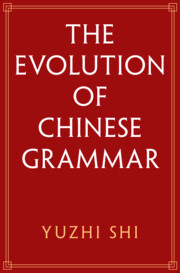Book contents
- The Evolution of Chinese Grammar
- The Evolution of Chinese Grammar
- Copyright page
- Dedication
- Epigraph
- Contents
- Figures
- Tables
- Acknowledgments
- Conventions Used in the Examples
- Abbreviations and Symbols
- 1 Some Preliminaries
- 2 Copular Word and Construction
- 3 Focus and Wh- Words
- 4 Serial Verb Construction
- 5 Disyllabification
- 6 Resultative Construction
- 7 Information Structure
- 8 The Passive Construction
- 9 The Disposal Construction
- 10 Verb Copying and Reduplication
- 11 The Comparative Construction
- 12 The Ditransitive Construction
- 13 Aspect and Tense
- 14 Negation
- 15 The Boundedness of the Predicate
- 16 Classifiers
- 17 Demonstratives from Classifiers
- 18 Distal Demonstratives from Phonological Derivation
- 19 Pronouns, Plurals, and Diminutives
- 20 Structural Particles
- 21 Word Order and Relative Clauses
- 22 Conclusions
- References
- Primary Sources of Texts
- Index
12 - The Ditransitive Construction
Published online by Cambridge University Press: 16 March 2023
- The Evolution of Chinese Grammar
- The Evolution of Chinese Grammar
- Copyright page
- Dedication
- Epigraph
- Contents
- Figures
- Tables
- Acknowledgments
- Conventions Used in the Examples
- Abbreviations and Symbols
- 1 Some Preliminaries
- 2 Copular Word and Construction
- 3 Focus and Wh- Words
- 4 Serial Verb Construction
- 5 Disyllabification
- 6 Resultative Construction
- 7 Information Structure
- 8 The Passive Construction
- 9 The Disposal Construction
- 10 Verb Copying and Reduplication
- 11 The Comparative Construction
- 12 The Ditransitive Construction
- 13 Aspect and Tense
- 14 Negation
- 15 The Boundedness of the Predicate
- 16 Classifiers
- 17 Demonstratives from Classifiers
- 18 Distal Demonstratives from Phonological Derivation
- 19 Pronouns, Plurals, and Diminutives
- 20 Structural Particles
- 21 Word Order and Relative Clauses
- 22 Conclusions
- References
- Primary Sources of Texts
- Index
Summary
The ditransitive construction is an essential grammatical device that has always existed throughout the history of Chinese. However, its semantic and syntactic properties have varied quite dramatically over time due to the influence of the general grammatical system in different periods. Generally, the ditransitive construction of the Chinese language has undergone a typological change, which makes the Chinese ditransitive construction inconsistent with SVO languages.
Keywords
- Type
- Chapter
- Information
- The Evolution of Chinese Grammar , pp. 296 - 325Publisher: Cambridge University PressPrint publication year: 2023

